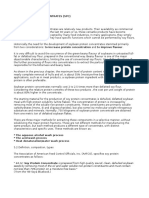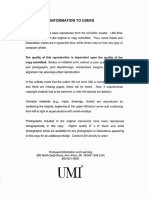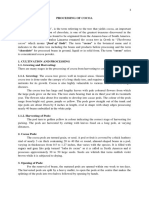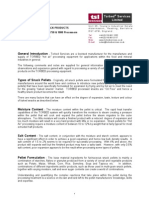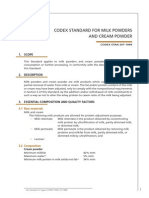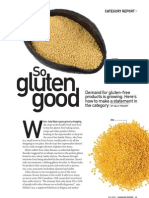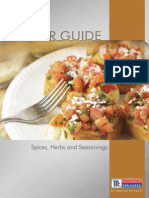Professional Documents
Culture Documents
Study On Physico-Chemical Properties of Developed Ready To Use Health Beverage Containing Coffee
Uploaded by
Anonymous izrFWiQOriginal Title
Copyright
Available Formats
Share this document
Did you find this document useful?
Is this content inappropriate?
Report this DocumentCopyright:
Available Formats
Study On Physico-Chemical Properties of Developed Ready To Use Health Beverage Containing Coffee
Uploaded by
Anonymous izrFWiQCopyright:
Available Formats
Volume 4, Issue 3, March – 2019 International Journal of Innovative Science and Research Technology
ISSN No:-2456-2165
Study on Physico-Chemical Properties of Developed
Ready to Use Health Beverage Containing Coffee
Poornima. S. P, Dr. D. B. Puranik.
Dairy Science College, Hebbal, Bengaluru
Karnataka, India.
Abstract:- A ready to use health beverage was fruit pulps, herbs and certain micro and macro nutrients
developed by replacing part of doubled toned milk with etc. Hence, different types of functional beverages are
cheddar cheese whey (30 %) and adding various growing promptly in the beverage market because of their
functional ingredients such as stevia (0.01 %), walnut health reimbursements such as immune enhancing,
oil (2 %) and coffee decoction (15 %). The various promoting health benefits for digestive or heart health,
physico-chemical properties of the developed healthy sporting drinks etc.
coffee beverage such as specific gravity, viscosity, pH,
acidity, moisture, total solids, fat, protein, total sugar Whey contains nearly 50 % of milk solids, which
and ash content were determined against control represents a heterogeneous pool of protein with wide range
beverage. It was observed that there was a decrease in of physicochemical and functional properties. Proteins that
specific gravity and pH values and an increase in constitute whey protein concentrate include β-lactoglobulin
acidity and viscosity of developed health beverage and α-lactalbumin, protease peptone, immunoglobulins,
compared to control beverage. Also, an increase in fat, bovine serum albumin, lactoferrin, lactoperoxidase, and
protein and ash content was observed with some peptides such as glycomacropeptide, which is the
simultaneous decrease in total solids and sugar content source of Branched-Chain amino acids. Whey proteins are
in health beverage compared to control. rich in essential amino acids and have high Protein
Efficiency Ratio (PER-3.6), Biological Value (BV-104)
Keywords:- Health Beverage, Walnut Oil, Coffee, Physical and Net Protein Utilization (NPU-95) (Rebaca, 2013).
Properties, Chemical Composition. Functional properties of protein in food systems are those
physico-chemical properties, which provide the desired
I. INTRODUCTION organoleptic or textural characteristics on the product in
which they are used. Whey proteins could be used as
The fast growing population, changing lifestyle of the component of foods for functional, nutritional and
consumer, are now looking for a product that provide value economic benefits.
additions beyond the nutrition. This value may be of
specific health benefit such as disease risk reduction Stevia (Stevia rebaudiana bertoni) is a herb of the
ability, the general well-being or the other health benefits. 950 genera of Asteraceae family well known locally as a
An increase in trend is seen towards developing low sweet herb or honey leaf, widely used by herbalists as
calorie/ low fat / skimmed products or a products with sweetener to sweeten local drinks, with medicines or as a
healthy fats (PUFA), essential proteins (BCAA), low sweet treat. Stevia is found to be 300 times sweeter than
calorie carbs because of health consciousness of the sucrose and hence can be used as a sugar substitute in low
consumers. Dairy forms a better platform for developing calorie beverages. The leaves of stevia contains 6.2 %
and providing various functional health beverages to such protein and 5.6 % lipid on a dry-weight basis, as well as
group of individuals to maintain their overall wellbeing. diterpene, triterpenes, sterols, flavonoids and other
compounds Stevia has been awarded the GRAS status with
Milk which is derived from cattle species which acts 4 mg/kg body weight ADI and extracted stevia product has
as an important source of nutrition. Milk is rich many found its application in food preparation as non-nutritive
nutrients such as carbohydrates (lactose), proteins (casein and high-intensity sweetener (Kuntz et al., 2010).
and whey proteins) and additional supply of fat, essential
vitamins and minerals which forms a vital source of Walnut (Juglansregia L.) is a member of
nutrition due to positive impact on the human physiology Juglandaceae family, one of the finest nuts of the temperate
and metabolism. In this contemporary-modern grab and go regions. Ripe walnut are eaten as dessert nuts or used in
era, ready-to-drink or ready-to-serve or ready-to-use cakes, desserts and confectioneries. Walnuts contain about
functional and nutraceutical beverage are the latest 52 - 70 % fat, 3.2 - 4.4 % water, 12.0-19.6 % protein, 61.3
breakthrough in the dairy beverage industry. Milk - 73.8 % fat, 1.8 - 2.3 % ash and 2.2 - 4.5 % sugars (Gecgel
beverages are considered as one of palpable thirst et al., 2017). Walnuts are rich good fat, is also rich i.e. 100
quenching and health-giving product. g of walnut contains approximately 6.5 g of saturated fat,
47 g of polyunsaturated fat and 9 g of monounsaturated fat
There different varieties of milk based beverages (Linda et al., 2004).
such as fat free, low fat, flavoured milks either enriched or
supplemented with some nutrients such as whey proteins,
IJISRT19MA654 www.ijisrt.com 618
Volume 4, Issue 3, March – 2019 International Journal of Innovative Science and Research Technology
ISSN No:-2456-2165
The major fatty acids in walnut oil especially Preparation: Control beverage was prepared by
polyunsaturated fatty acid shown enhance shelf life with using double toned milk with 8 % sugar addition (Singh.,
potential health benefits. It is also reported that walnuts 2004). Ready to use health beverage was prepared by
have many health beneficial properties such as antifungal replacing 30 % of double toned milk with whey, complete
activity, antiviral activity, antioxidant activity, antidiabetic replacement of sugar with stevia and 2 % walnut oil was
activity, antidepressant activity, antityrosinase activity, added. Coffee decoction was added at the rate of 15 % and
hypotriglyceridemic activity, anticancer activity and many the ingredients were blended together and pasteurized at
other medicinal uses (Fukuda et al., 2004 and Taha et al., 72°C/5-6 sec, later bottled and stored at refrigeration
2011). As a matter of fact, human body cannot metabolize condition until used for analysis.
the essential fatty acids on its own, hence it require an
external source to meet the requirement. Walnut oil, being Analysis of physical properties:
rich in PUFA forms a source of omega-3 fatty acid which
is essential for normal functioning of nervous system, pH: The pH was measured using a digital pH meter
retina and brain. Hence, fortification of milk beverage with (ElicoPvt. Ltd.) at 25 ˚C. About 20ml of representative
walnut oil can deliver substantial amount of omega 3 fatty samples were used.
acids.
Specific gravity: Specific gravity was estimated at 30
Coffee (Coffee arabica or robusta) is the biggest ºC by using a standard specific gravity bottle of 50 ml
source of antioxidants in the diet. Coffee is generally a capacity, taking distilled water as the standard liquid.
brewed drink prepared from roasted coffee beans, which
are the seeds of berries from the coffee plant. The global Viscosity: Viscosity of samples was estimated using
production of coffee in 2017 was approximately 158.93 U-tube viscometer by taking distilled water as standard
million kg where in India it was accounting around 5.84 liquid.
million kg. A 100 g of coffee consists of caffeine (40 mg),
potassium (49 mg) and sodium (2 mg) (International coffee Relative viscosity can be calculated by multiplying
organization, 2018). average time for flow and specific gravity of product
divided by average time for flow of water.
The consumption of coffee has been associated with
several health benefits, including a reduced risk of diabetes Analysis of chemical properties: The standard
and cardiovascular disease. Clinical and epidemiological method mentioned in ISI: SP 18 (Part XI) 1981 was
studies have found the consumption of coffee found to be followed for estimation of moisture, total solids, lactose
associated with risk reductions for the development of (Lane Eynon method), fat (Gerber method), protein
diabetes, Alzheimer’s disease, several cancers, liver (Micro-Kjeldhal protein), ash and tritrable acidity.
diseases and cardiovascular disease due to its bioactive
constituents, which include phenolic compounds, caffeine, Statistical analysis: Results obtained were average of
diterpenes, melanoidins, and trigonelline (Loader et al., three replications which was statistically analysed by
2017). subjecting to statistical analysis (R Programme, R-Version,
Ri386 3.4.3) for accurate interpretation that helped in
In order to increase the assortment of functional discussion (Zar, 2003).
beverages, whey added can be a source of proteins
(BCCA), stevia as a low calorie- sweetening agent, walnut III. RESULT AND DISCUSSION
oil as a source of essential fatty acid (ω-3) and coffee as
flavour enhancer and health promoting substance. Thus, Effect of addition of whey, stevia, walnut oil and
the aim of this study is to evaluate the physico-chemical coffee on the physical properties of ready to use health
characteristics of developed ready-to-use health beverage. beverage: The specific gravity, viscosity, pH and acidity of
control were 1.034, 1.76 cP, 6.67 and 0.14 % LA,
II. MATERIALS AND METHOD respectively whereas the health beverage containing coffee
showed 1.0301, 1.88 cP, 6.59 and 0.15 % lactic acid,
Ingredients: Fresh double toned milk was obtained respectively (Table 1). It was observed that there was a
by separating the cow’s milk using cream separator, skim decrease in specific gravity and increase in viscosity of
milk powder and cream was used for standardization. developed health beverage compared to control beverage.
Cow’s milk procured from the student experimental dairy This could be due to the incorporation of walnut oil blend
plant (SEDP) was used for the preparation of cheese and as increase in fat content increases the viscosity. Also the
the whey separated out was used for the research work. developed health beverage showed a slight increase in the
Good quality cane sugar, stevia-natural sweetener (8 times acidity and decrease in pH compared to control beverage
sweeter than sucrose), walnut oil and coffee powder were which could be due to the addition of whey (0.05 % LA),
procured from local market. Coffee decoction was tea (pH 6.2) and coffee (pH 5.3) decoction which are acidic
prepared by using 100 ml demineralized water and coffee in nature.
powder in filter coffee machine and obtained decoction
was used in this research work. These results were in agreement with that of Singh et
al., 2005 where carrot flavoured milk beverage showed
IJISRT19MA654 www.ijisrt.com 619
Volume 4, Issue 3, March – 2019 International Journal of Innovative Science and Research Technology
ISSN No:-2456-2165
specific gravity in the range of 1.061-1.065, viscosity of of 0.13-0.14% LA.
27.-27.4 sec, pH in range of 6.44-6.69 and acidity in range
Parameter B1 B2 CD
(P=.05)
Specific gravity 1.034a 1.031b 0
a
Viscosity (cP at 25 °C) 1.54 1.88b 0.009
pH 6.67a 6.59b 0.031
Acidity (% LA) 0.14b 0.15a 3.05
Table 1:- Effect of addition of whey, stevia, walnut oil and coffee on the physical properties of ready to use health beverage
Note
All values are average of three trials
Superscripts – a & b indicate significance difference at the corresponding critical difference
B1 & B2 : Control and developed ready to use health beverage, respectively
Fig 1:- Effect of addition of whey, stevia, walnut oil and coffee on the physical properties of ready to use health beverage
Effect of addition of whey, stevia, walnut oil and in per cent fat which could be due to addition of walnut oil
coffee on the chemical properties of ready to use health (2 %), protein content was increased due to contribution of
beverage: The chemical composition of control beverage added whey (0.60 %) and increase in ash content can be
and developed ready to use health beverages are tabulated attributed due to addition of whey (0.5 %) and coffee (0.02
in Table 2. It was observed that there was a decrease in %) in developed health beverage which was similarly
total solids and total sugar content in developed health reported by Chatterjee et al. (2015) were 3:2 ratio for
beverages than control beverage, which clearly shows the concentrated liquid whey and orange juice added with 8 %
effect of stevia on the total sugar content. The addition of sugar had moisture, total soluble solids, fat, protein, total
biosweetener significantly effected total sugar content sugar and ash of 85.5 ± 0.79, 14.43 ± 0.25, 0.73 ± 0.4, 1.05
which forms an important attribute. Also there was increase ± 0.22, 4.52 ± 0.35 and 0.67 ± 0.06 %, respectively.
Parameter B1 B2 CD
(P=.05)
Moisture 81.35b 87.31a 0.00
Total solids 18.30a 12.69b 0.00
Fat 1.55b 3.74a 0.03
Protein 3.28b 3.53a 0.04
Total sugar 12.76a 4.50b 0.10
Ash 0.71b 0.92a 0.02
Table 2: Effect of addition of whey, stevia, walnut oil and coffee on the chemical properties of ready to use health beverage
Note
All values are average of three trials
Superscripts – a & b indicate significance difference at the corresponding critical difference
B1 & B2 : Control and developed ready to use health beverage, respectively
IJISRT19MA654 www.ijisrt.com 620
Volume 4, Issue 3, March – 2019 International Journal of Innovative Science and Research Technology
ISSN No:-2456-2165
IV. CONCLUSION
It can be concluded from the results that the ready to
use health beverage prepared by the addition of whey,
natural sweetener stevia, walnut oil and coffee have shown
lesser effect on the physico-chemical properties. Hence,
development of ready to use health beverage containing
essentials nutrients such as whey protein, zero calorie stevia,
addition of healthy fat such as ω-3 fatty acids rich walnut oil
and coffee as an antioxidant and flavour enhancer can act as
an interesting opportunity to manufacture low calorie health
beverage that will be considered satisfactory by consumers.
REFERENCES
[1]. CHATTERJEE, G., NEVE, D.J., DUTTA, A. and
DAS, S., 2015. Formulation and statistical evaluation
of a ready-to-drink whey based orange beverage and
its storage stability. Revista Mexicana de Ingenierıa
Quımica. 14(2): 253-264.
[2]. FUKUDA, T., ITO, H. and YOSHIDA, T.2004. Effect
of walnut polyphenol fraction on oxidative stress in
type 2 diabetes mice. BioFactors 21(4): 251-253.
[3]. GECGEL, U., GUMUS, T., TASAN, M. and ARICI,
M., 2017. Determination of fatty acid composition of
irradiated hazelnuts, walnuts, almonds, and pistachios.
Radiation Phys. and Chem.80(4):578-58.
[4]. INTERNATIONAL COFFEE ORGANIZATION.
2018. www.ico.or
[5]. IS: SP: 18, 1981. ISI Handbook of Food Analysis, part
XI, dairy products, Indian Standards Institution,
Manak Bhavan, New delhi, India.
[6]. IS: 1224 (Part I)-1977. Determination of fat by Gerber
method, ISI, New Delhi.
[7]. IS: 5194, 1969.Method of determination of nitrogen by
Kjeldhal method, ISI, New Delhi
[8]. KUNTZ, L.A., 2010.Stevia’s sweet story. Food
Product Design. 20(5):1-6.
[9]. LOADER, T.B., TAYLOR, C.G., ZAHRADKA, P.
and JONES, P.J., 2017. Chlorogenic acid from coffee
beans: evaluating the evidence for a blood pressure-
regulating health claim. Nutr. Rev.75(2):114-133.
[10]. REBAKA, 2013. Development of ready-to-
reconstitute milk beverages. M.Sc. thesis. Karnataka
Veterinary, Animal and Fisheries Sciences University,
campus, Bangalore, India.
[11]. SINGH, C., GREWAL, K.S. and SHRAMA, H.K.,
2005. Preparation and properties of carrot flavoured
milk beverage. J. Dairying, Foods & H.S. 24(3/4):184-
189.
[12]. SINGH, S.2006. Cheese technology. Dairy
Technology. New India Publisher Agency. 2(2).pp:
564-567.
[13]. SP: 18 (Part XI) – 1981. ISI Handbook of food
analysis part XI Dairy Products, Indian Standards
Institution, New Delhi, India.
[14]. TAHA, N.A. and WADAAN, A.A.2011. Utility and
importance of walnut, Juglans regia Linn: A review.
African J. Mic. Research. 5(32):5796-5805.
[15]. ZAR, J. H., 2003. Bio statistical analysis. J. H. Pub.
Pearson Edu. Pvt. Ltd., New Delhi.
IJISRT19MA654 www.ijisrt.com 621
You might also like
- The Staling of Coffee IDocument20 pagesThe Staling of Coffee IdartstudNo ratings yet
- Soybean Protein Concentrates-FAODocument6 pagesSoybean Protein Concentrates-FAOyanxunNo ratings yet
- Manual of Quality Analysis-Soy-ProductsDocument115 pagesManual of Quality Analysis-Soy-ProductsGeorge Van BommelNo ratings yet
- Leaflet - Milk FermentationDocument3 pagesLeaflet - Milk FermentationNoor SultanNo ratings yet
- Soybean Protein Concentrates (SPC)Document7 pagesSoybean Protein Concentrates (SPC)Tayyab Tahir MinhasNo ratings yet
- Functional Foods ExplainedDocument25 pagesFunctional Foods ExplainedratnarosmaNo ratings yet
- Total Sugar DeterminationDocument5 pagesTotal Sugar DeterminationClint Charles P. BrutasNo ratings yet
- SJPM 1242 49Document8 pagesSJPM 1242 49Richard ObinnaNo ratings yet
- Dairy Food Ingredients Chapter 4: Milk Powders and Whey ProteinsDocument33 pagesDairy Food Ingredients Chapter 4: Milk Powders and Whey ProteinsVanessa LimNo ratings yet
- MOFPIDocument42 pagesMOFPIcardticket0% (2)
- Variety and Shelf Life of Coffee Packaged in Capsules 2020 LWTDocument9 pagesVariety and Shelf Life of Coffee Packaged in Capsules 2020 LWTElif BağcıvancıoğluNo ratings yet
- Categorization and Sensory Profiling of Functional BeveragesDocument197 pagesCategorization and Sensory Profiling of Functional Beveragescklcat1437No ratings yet
- tmp8203 TMPDocument49 pagestmp8203 TMPFrontiersNo ratings yet
- Wa0003Document29 pagesWa0003jonathanNo ratings yet
- A Detailed Analysis of Complan Nutri-Gro and Comparison With The Competitors ProductsDocument40 pagesA Detailed Analysis of Complan Nutri-Gro and Comparison With The Competitors ProductsSami Zama100% (1)
- High Yield Coffee Extraction Technology: Figure 1: SPX E&e Coffee Evaporation PlantDocument3 pagesHigh Yield Coffee Extraction Technology: Figure 1: SPX E&e Coffee Evaporation PlantTien NguyenNo ratings yet
- HPP Food Processing Extends Shelf LifeDocument13 pagesHPP Food Processing Extends Shelf LifeAHANA mahboobNo ratings yet
- Flavour TechnologyDocument22 pagesFlavour TechnologyAnubhav SrivastavNo ratings yet
- Instant NoodlesDocument11 pagesInstant NoodlesBryan LeeNo ratings yet
- Tops Internship ReportDocument62 pagesTops Internship ReportAilia Batool100% (1)
- Exp 4 MilkDocument10 pagesExp 4 MilkWan XïnNo ratings yet
- The Frying Process: Università Degli Studi Di ParmaDocument13 pagesThe Frying Process: Università Degli Studi Di ParmarinthusNo ratings yet
- Plant-Based Milk Alternatives An Emerging Segment of Functional Beverages: A ReviewDocument16 pagesPlant-Based Milk Alternatives An Emerging Segment of Functional Beverages: A ReviewRafael LuchaNo ratings yet
- Australian Fruit Juice Parameters GuideDocument109 pagesAustralian Fruit Juice Parameters GuideEstefania Muñoz JiménezNo ratings yet
- Laboratory Manual FOT440 Traditional and Value Added Dairy ProductsDocument7 pagesLaboratory Manual FOT440 Traditional and Value Added Dairy ProductsVeeraprasad CGNo ratings yet
- Cambodia Food Safety FrameworkDocument3 pagesCambodia Food Safety FrameworkRupali Pratap SinghNo ratings yet
- Soy Proteins A Review On Composition, Aggregation and EmulsificationDocument18 pagesSoy Proteins A Review On Composition, Aggregation and EmulsificationkesdamileNo ratings yet
- Hafiz Zahid Mehmood Ph.D. Agriculturl EconomicsDocument17 pagesHafiz Zahid Mehmood Ph.D. Agriculturl Economicshafiz zahidNo ratings yet
- Asokapandian 2019 - Deep Fat Frying of Foods A Critical Review OnDocument15 pagesAsokapandian 2019 - Deep Fat Frying of Foods A Critical Review OnsutarsiNo ratings yet
- Thesis Proposal On Studies On Development and Storage of Whey Based Mango BeverageDocument14 pagesThesis Proposal On Studies On Development and Storage of Whey Based Mango Beveragemilan poudelNo ratings yet
- 1587535182unit III Processing of CocoaDocument8 pages1587535182unit III Processing of Cocoaabdelsalam alhaggarNo ratings yet
- Patent Application For Production of Lactose Free MilkDocument6 pagesPatent Application For Production of Lactose Free MilkJohn OsborneNo ratings yet
- Soy Sauce Production FinalDocument40 pagesSoy Sauce Production FinalKonpal PaliNo ratings yet
- Advances in Dairy ProductsFrom EverandAdvances in Dairy ProductsFrancesco ContoNo ratings yet
- Mango SeedDocument8 pagesMango SeedAisha AkramNo ratings yet
- CaseStudy - Botulism in Argenna Student VersionDocument25 pagesCaseStudy - Botulism in Argenna Student Versionlei8823No ratings yet
- 16 SnacksDocument3 pages16 SnacksadityarmehtaNo ratings yet
- Beverages 2Document15 pagesBeverages 2pawanNo ratings yet
- Food SpoilageDocument13 pagesFood SpoilageKrithishNo ratings yet
- 2021 Food Safety Officer Book - SWA EducationDocument552 pages2021 Food Safety Officer Book - SWA EducationMaritza Mercedes Zambrano IntriagoNo ratings yet
- Noodle List 01Document6 pagesNoodle List 01chea sok hunNo ratings yet
- Milk Powder and Cream PowderDocument5 pagesMilk Powder and Cream PowderNat TangsuphoomNo ratings yet
- Physicochemical Properties of Banana Peel Flour As Influenced by Variety and Stage of Ripeness Multivariate Statistical AnalysisDocument14 pagesPhysicochemical Properties of Banana Peel Flour As Influenced by Variety and Stage of Ripeness Multivariate Statistical AnalysisnalmondsNo ratings yet
- Processing of Buttermilk NotesDocument3 pagesProcessing of Buttermilk NotesArjun VasudevNo ratings yet
- By Products TechnologyDocument234 pagesBy Products TechnologyTara NahNo ratings yet
- IntroductionDocument4 pagesIntroductionsumit_kumar3No ratings yet
- Planting. Coffee Is A Crop That Mostly Grows On Tropical and Subtropical Climates. Usually, TheseDocument8 pagesPlanting. Coffee Is A Crop That Mostly Grows On Tropical and Subtropical Climates. Usually, Theseimo konsensyaNo ratings yet
- Quantiplate Protocol Quantum Blue BWDocument10 pagesQuantiplate Protocol Quantum Blue BWIrene Sinung HaripratiwiNo ratings yet
- Dehydrated Fruit and VegetablesDocument17 pagesDehydrated Fruit and Vegetableskassahun meseleNo ratings yet
- Ragi Mudde: Slurpyplat T e R.blo Gspo T .InDocument5 pagesRagi Mudde: Slurpyplat T e R.blo Gspo T .Innemo3045No ratings yet
- Analysis Methods of Contents in SoymilkDocument5 pagesAnalysis Methods of Contents in SoymilkDiksha Gupta100% (1)
- Yeast ExtractsDocument3 pagesYeast ExtractsSorindah MolinaNo ratings yet
- Rus SipDocument21 pagesRus SipkoolyarNo ratings yet
- Mixing Dairy ConcentratesDocument2 pagesMixing Dairy ConcentratesMadhu KrisNo ratings yet
- Fat Rich Dairy Products Technology 1.0 PDFDocument214 pagesFat Rich Dairy Products Technology 1.0 PDFisabeljanuarioNo ratings yet
- Potato Production, Processing and Trade TrendsDocument125 pagesPotato Production, Processing and Trade Trendsbalaji19745No ratings yet
- Fats and Oils Herbs and SpicesDocument69 pagesFats and Oils Herbs and SpicesSwapnil LilkeNo ratings yet
- EggDocument33 pagesEggrajesh100% (3)
- Application of Hydrocolloids As Coating PDFDocument9 pagesApplication of Hydrocolloids As Coating PDFRadwan AjoNo ratings yet
- CH572 PDFDocument1 pageCH572 PDFHemalatha HemuNo ratings yet
- Teacher Leaders' Experience in The Shared Leadership ModelDocument4 pagesTeacher Leaders' Experience in The Shared Leadership ModelAnonymous izrFWiQNo ratings yet
- Evaluation of Assessing The Purity of Sesame Oil Available in Markets of India Using Bellier Turbidity Temperature Test (BTTT)Document4 pagesEvaluation of Assessing The Purity of Sesame Oil Available in Markets of India Using Bellier Turbidity Temperature Test (BTTT)Anonymous izrFWiQNo ratings yet
- Bioadhesive Inserts of Prednisolone Acetate For Postoperative Management of Cataract - Development and EvaluationDocument8 pagesBioadhesive Inserts of Prednisolone Acetate For Postoperative Management of Cataract - Development and EvaluationAnonymous izrFWiQNo ratings yet
- Analysis of Ancol Beach Object Development Using Business Model Canvas ApproachDocument8 pagesAnalysis of Ancol Beach Object Development Using Business Model Canvas ApproachAnonymous izrFWiQNo ratings yet
- Investigations On BTTT As Qualitative Tool For Identification of Different Brands of Groundnut Oils Available in Markets of IndiaDocument5 pagesInvestigations On BTTT As Qualitative Tool For Identification of Different Brands of Groundnut Oils Available in Markets of IndiaAnonymous izrFWiQNo ratings yet
- Securitization of Government School Building by PPP ModelDocument8 pagesSecuritization of Government School Building by PPP ModelAnonymous izrFWiQNo ratings yet
- Experimental Investigation On Performance of Pre-Mixed Charge Compression Ignition EngineDocument5 pagesExperimental Investigation On Performance of Pre-Mixed Charge Compression Ignition EngineAnonymous izrFWiQNo ratings yet
- Platelet-Rich Plasma in Orthodontics - A ReviewDocument6 pagesPlatelet-Rich Plasma in Orthodontics - A ReviewAnonymous izrFWiQNo ratings yet
- Incidence of Temporary Threshold Shift After MRI (Head and Neck) in Tertiary Care CentreDocument4 pagesIncidence of Temporary Threshold Shift After MRI (Head and Neck) in Tertiary Care CentreAnonymous izrFWiQNo ratings yet
- IJISRT19AUG928Document6 pagesIJISRT19AUG928Anonymous izrFWiQNo ratings yet
- Closure of Midline Diastema by Multidisciplinary Approach - A Case ReportDocument5 pagesClosure of Midline Diastema by Multidisciplinary Approach - A Case ReportAnonymous izrFWiQNo ratings yet
- Design and Analysis of Humanitarian Aid Delivery RC AircraftDocument6 pagesDesign and Analysis of Humanitarian Aid Delivery RC AircraftAnonymous izrFWiQNo ratings yet
- Risk Assessment: A Mandatory Evaluation and Analysis of Periodontal Tissue in General Population - A SurveyDocument7 pagesRisk Assessment: A Mandatory Evaluation and Analysis of Periodontal Tissue in General Population - A SurveyAnonymous izrFWiQNo ratings yet
- Knowledge and Utilisation of Various Schemes of RCH Program Among Antenatal Women and Mothers Having Less Than Five Child in A Semi-Urban Township of ChennaiDocument5 pagesKnowledge and Utilisation of Various Schemes of RCH Program Among Antenatal Women and Mothers Having Less Than Five Child in A Semi-Urban Township of ChennaiAnonymous izrFWiQNo ratings yet
- Child Rights Violation and Mechanism For Protection of Children Rights in Southern Africa: A Perspective of Central, Eastern and Luapula Provinces of ZambiaDocument13 pagesChild Rights Violation and Mechanism For Protection of Children Rights in Southern Africa: A Perspective of Central, Eastern and Luapula Provinces of ZambiaAnonymous izrFWiQNo ratings yet
- IJISRT19AUG928Document6 pagesIJISRT19AUG928Anonymous izrFWiQNo ratings yet
- Women in The Civil Service: Performance, Leadership and EqualityDocument4 pagesWomen in The Civil Service: Performance, Leadership and EqualityAnonymous izrFWiQNo ratings yet
- SWOT Analysis and Development of Culture-Based Accounting Curriculum ModelDocument11 pagesSWOT Analysis and Development of Culture-Based Accounting Curriculum ModelAnonymous izrFWiQNo ratings yet
- Application of Analytical Hierarchy Process Method On The Selection Process of Fresh Fruit Bunch Palm Oil SupplierDocument12 pagesApplication of Analytical Hierarchy Process Method On The Selection Process of Fresh Fruit Bunch Palm Oil SupplierAnonymous izrFWiQNo ratings yet
- Comparison of Continuum Constitutive Hyperelastic Models Based On Exponential FormsDocument8 pagesComparison of Continuum Constitutive Hyperelastic Models Based On Exponential FormsAnonymous izrFWiQNo ratings yet
- A Wave Energy Generation Device Using Impact Force of A Breaking Wave Based Purely On Gear CompoundingDocument8 pagesA Wave Energy Generation Device Using Impact Force of A Breaking Wave Based Purely On Gear CompoundingAnonymous izrFWiQNo ratings yet
- Pharmaceutical Waste Management in Private Pharmacies of Kaski District, NepalDocument23 pagesPharmaceutical Waste Management in Private Pharmacies of Kaski District, NepalAnonymous izrFWiQNo ratings yet
- Enhanced Opinion Mining Approach For Product ReviewsDocument4 pagesEnhanced Opinion Mining Approach For Product ReviewsAnonymous izrFWiQNo ratings yet
- The Influence of Benefits of Coastal Tourism Destination On Community Participation With Transformational Leadership ModerationDocument9 pagesThe Influence of Benefits of Coastal Tourism Destination On Community Participation With Transformational Leadership ModerationAnonymous izrFWiQNo ratings yet
- Assessment of Health-Care Expenditure For Health Insurance Among Teaching Faculty of A Private UniversityDocument7 pagesAssessment of Health-Care Expenditure For Health Insurance Among Teaching Faculty of A Private UniversityAnonymous izrFWiQNo ratings yet
- Exam Anxiety in Professional Medical StudentsDocument5 pagesExam Anxiety in Professional Medical StudentsAnonymous izrFWiQ100% (1)
- To Estimate The Prevalence of Sleep Deprivation and To Assess The Awareness & Attitude Towards Related Health Problems Among Medical Students in Saveetha Medical CollegeDocument4 pagesTo Estimate The Prevalence of Sleep Deprivation and To Assess The Awareness & Attitude Towards Related Health Problems Among Medical Students in Saveetha Medical CollegeAnonymous izrFWiQNo ratings yet
- Trade Liberalization and Total Factor Productivity of Indian Capital Goods IndustriesDocument4 pagesTrade Liberalization and Total Factor Productivity of Indian Capital Goods IndustriesAnonymous izrFWiQNo ratings yet
- Effect Commitment, Motivation, Work Environment On Performance EmployeesDocument8 pagesEffect Commitment, Motivation, Work Environment On Performance EmployeesAnonymous izrFWiQNo ratings yet
- Revived Article On Alternative Therapy For CancerDocument3 pagesRevived Article On Alternative Therapy For CancerAnonymous izrFWiQNo ratings yet
- A Presentation On Cost Analysis of CadburyDocument11 pagesA Presentation On Cost Analysis of CadburyHarsh JainNo ratings yet
- It Was Haunted.: Mark The Letter A, B, C, or D To Indicate The Correct Answer To Each of The Following QuestionsDocument3 pagesIt Was Haunted.: Mark The Letter A, B, C, or D To Indicate The Correct Answer To Each of The Following QuestionsKhôiNo ratings yet
- Corn BleachingDocument3 pagesCorn BleachingMaria Elaine AlbiusNo ratings yet
- HEMRYDocument2 pagesHEMRYavnisharyaNo ratings yet
- ppsDAFTAR ELEKTROLIT KONSENTRATDocument1 pageppsDAFTAR ELEKTROLIT KONSENTRATNitaNo ratings yet
- 2010 05 11 Gluten Free DemandDocument3 pages2010 05 11 Gluten Free DemandShannon SadlerNo ratings yet
- Bread and Pastry Production NC II - PptxoverviewDocument16 pagesBread and Pastry Production NC II - PptxoverviewMa. Luisa A. Angsinco100% (3)
- Report Highlights Street Vending Issues in ChennaiDocument16 pagesReport Highlights Street Vending Issues in ChennaiPavithra SwaminathanNo ratings yet
- Inglés: Cuaderno de TrabajoDocument3 pagesInglés: Cuaderno de TrabajoJavier SerrepeNo ratings yet
- 09.review On The Physicochemical Properties, Modifications, and Applications of Starches and Its Common Modified Forms Used in Noodle ProductsDocument25 pages09.review On The Physicochemical Properties, Modifications, and Applications of Starches and Its Common Modified Forms Used in Noodle ProductsKiefer YuNo ratings yet
- Bread and Pastry 10Document54 pagesBread and Pastry 10Al Lhea Bandayanon Morales100% (2)
- Composition About Being HungryDocument2 pagesComposition About Being HungryJacyntha Koh100% (1)
- Customer Service Training ManualDocument55 pagesCustomer Service Training ManualVJ Gabrielle SantosNo ratings yet
- 1993 Utah Native Plant Society Annual CompliationsDocument63 pages1993 Utah Native Plant Society Annual CompliationsFriends of Utah Native Plant SocietyNo ratings yet
- SEO-Optimized Guide to Forming Plural NounsDocument16 pagesSEO-Optimized Guide to Forming Plural NounsRicardoVernautJunior100% (1)
- NEHHDC Handicrafts Catalogue 2021 v2Document49 pagesNEHHDC Handicrafts Catalogue 2021 v2readalot61No ratings yet
- Cards Against HumanityDocument23 pagesCards Against HumanityRyan HarleNo ratings yet
- Degree of Comparison PDFDocument34 pagesDegree of Comparison PDFdeasyraNo ratings yet
- Backpacker Risk NarrativesDocument21 pagesBackpacker Risk NarrativesMaria LeiteNo ratings yet
- Hotel 88 Food and BeverageDocument12 pagesHotel 88 Food and BeverageCarlos DungcaNo ratings yet
- Local Materials Used in Creating ArtDocument20 pagesLocal Materials Used in Creating ArtNancy Medina CabalunaNo ratings yet
- ĐỀ SỐ 29Document7 pagesĐỀ SỐ 29Joy English TeachersNo ratings yet
- Poultry Processing: The World ofDocument26 pagesPoultry Processing: The World ofAssane RoqueNo ratings yet
- Global Organic Textile StandardDocument2 pagesGlobal Organic Textile StandardShanti PutriNo ratings yet
- Microbial Safety of Minimally Processed FoodsDocument357 pagesMicrobial Safety of Minimally Processed FoodsGaganpreet KaurNo ratings yet
- Flavor GuideDocument6 pagesFlavor GuideShishir Kumar SinghNo ratings yet
- Never Worry About Disease Again with Advanced Healing TechniquesDocument51 pagesNever Worry About Disease Again with Advanced Healing TechniquesVictorFaucheret100% (2)
- Physical and Chemical Control of MicrobesDocument23 pagesPhysical and Chemical Control of MicrobesFaye Y. SantiagoNo ratings yet
- Molecules: Quality Characteristics and Volatile Profile of Macarons Modified With Walnut Oilcake By-ProductDocument19 pagesMolecules: Quality Characteristics and Volatile Profile of Macarons Modified With Walnut Oilcake By-ProductDanaNo ratings yet
- 9781473615441 (1)Document449 pages9781473615441 (1)iki29275% (4)




